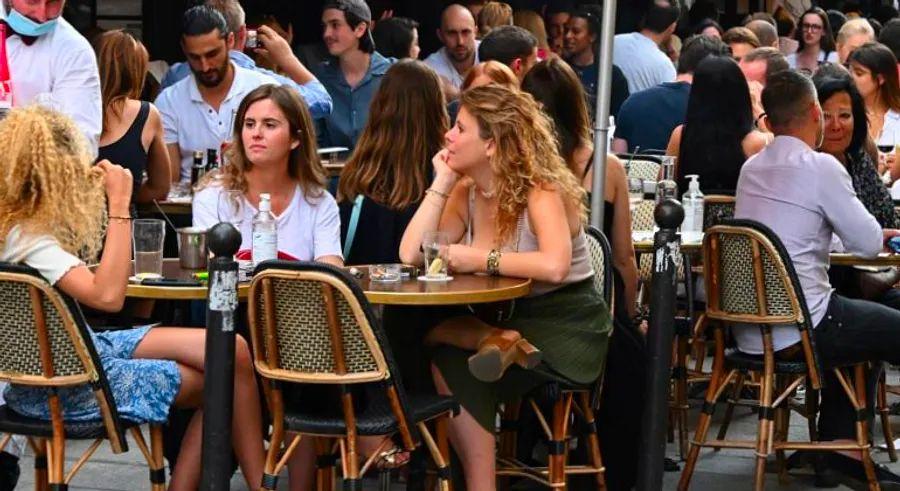Visiting Paris After Lockdown

Every table at the Parisian bistro Chez L’Ami Jean is now topped with a garden bucket of disposable wipes and large bottles of hand sanitizer.
At the entrance to the high-end Galeries Lafayette, security staff, who also oversee hygiene, generously apply sanitizer to every shopper’s hands.
Along one of Paris's busiest roads, cars and scooters have made way for a growing group of cycling commuters, some in business suits, others in skirts, all pedaling side by side in a purposeful, yet orderly manner.
On Thursday, the Eiffel Tower’s metal stairs began ringing once more with the sound of visitors climbing for a panoramic view of Paris, while the elevators remain out of use.
Welcome to post-lockdown Paris, where face masks, floor markings, acrylic barriers, and copious amounts of hand sanitizer have become the new standard.
Since June 2, Paris has gradually begun reopening, with residents able to visit parks and leave their homes without needing to justify their outings. Then, on June 15, restaurants and cafés were given the green light to welcome guests again, marking the clear end of the lockdown.
Reinventing Dining Out

Without the lively buzz of cafés, outdoor terraces, bistros, and bars, Paris feels like a different city altogether.
At Chez L’Ami Jean in the 7th arrondissement, Chef Stéphane Jégo has removed the traditional banquette seating and carefully rearranged tables to comply with France’s three-foot social distancing requirement.
To make up for losing half of the 55 dining room seats, the chef has transformed former street parking spots into a new outdoor patio.
This is a big shift for the bistro, beloved by both tourists and locals for its communal, family-style dining, where guests are often seated closely together in a bustling, joyous atmosphere.
To maintain the restaurant's signature atmosphere, Jégo had to rethink the layout of the space he has managed for the past 17 years.
He quickly devised a concept that brings the bistro back to its roots, reminiscent of nearly a century ago when it served coffee, wine, sandwiches, and local newspapers to the neighborhood.
The revamped restaurant now features a small market in its front window, offering local produce—such as cherries, heirloom carrots, and tomatoes—alongside homemade pâté and terrines.
To attract the after-work crowd and those coming for apéro, bar stools, high tables, and a tapas bar have been added to the bistro's front area, while a separate section inside offers a selection of the chef’s favorite wines.
In an effort to make Chez L’Ami Jean more accessible, the chef will only accept a limited number of reservations at a time.
The Absence of Tourists

"After being separated by this notorious virus, our goal was to bring back a sense of intimacy, closeness, and camaraderie at the restaurant," he explained.
This is a business strategy designed to diversify the restaurant’s appeal, while also attracting more local Parisians to make up for the absence of tourists, who once represented half of his regular customer base.
Though travel within the Schengen Area has resumed, and international travel from certain non-Schengen countries will be allowed starting July 1, it will be some time before travel returns to pre-Covid-19 levels.
Last year, the city welcomed 38 million visitors, with tourists from the US and UK topping the international markets. American travelers alone accounted for 2.56 million hotel bookings in 2019.
Seeing Paris without tourists has given some locals a clearer understanding of how much international visitors energize the city and contribute to its unique atmosphere.
On a recent visit to Montmartre, Parisian Huguette Dauria, 77, was struck by how empty the streets felt.
"All the shops were closed, and Montmartre was deserted. It was unsettling to see. The city felt so quiet. Tourists really bring the city to life," said the retired local.
Parisian museum worker Patricia Servain, 40, shares the same sentiment.
"It’s nice because there’s more space, but Paris has lost its cosmopolitan feel. I miss hearing all the different languages. If this continues, it will feel odd," she said.
Although the city has reopened, Dauria expressed her disappointment at seeing some Parisians ignoring social distancing guidelines and going without masks.
The World Health Organization advises wearing masks in public spaces when maintaining physical distance is not possible. Yet, Parisians have been quick to abandon face coverings on the streets, where they’re not required, now that the city is reopening.
"It seems like people haven’t really grasped what just happened," said Dauria.
"We need to stay vigilant to prevent a second wave, but people are strolling around without masks and gathering in large groups... It’s not right," she added.
Dauria’s husband, Daniel, remarks disapprovingly that everything has returned to how it was before.
"It’s as if we just woke up from a dream and none of this ever happened," he said.
Servain, on the other hand, admitted she has become more of a homebody since the lockdown and now avoids heavily crowded areas.
"The virus has made us rethink things," Jégo reflects.
From shopping and public transport to museum visits, here’s what the new normal will look like in Paris until a vaccine or treatment is found:
Public Transportation

To discourage overcrowding in the metro, where social distancing is nearly impossible during rush hour, the city has repurposed 31 miles of streets—typically used by cars—into temporary bike lanes.
The result? It feels as though the city's noise—honking horns and roaring engines—has been dialed down, providing a much-needed break for the nerves.
Men in suits, their blazers fluttering in the wind, ride alongside women in spring skirts and flats, students, and delivery bikers.
Hand sanitizer dispensers have been placed at select bus stops, and masks are now mandatory on all public transportation and in taxis.
Stickers are placed on train floors and on certain seats to guide passengers in maintaining social distance where possible.
Shopping

While masks are not required in public spaces, many private shops, boutiques, and large department stores mandate that all shoppers wear them during their visit.
Customers are encouraged to sanitize their hands at dispensers placed at shop entrances, and in some boutiques, visitors are asked not to touch or handle the products.
This means no swatching lipsticks or testing creams at the beauty counters, and no closely inspecting home décor items. Shoppers are also reminded to maintain a safe distance—at least three steps apart on the escalators at Galeries Lafayette—and acrylic barriers separate them from sales associates at the checkout.
Museums and Landmarks

No more crowds around the Mona Lisa. At the Louvre, which reopens on July 6, visitors must buy tickets in advance online and select a time slot, similar to booking an appointment or movie showtime, to manage crowd flow.
Visitors must also follow a designated route to popular artworks and exhibits, like the Mona Lisa, to reduce congestion. Same-day tickets will be available at the museum, but priority will be given to those with online reservations.
Similarly, visitors are required to purchase tickets in advance online for both the Musée d’Orsay and the Palace of Versailles.
The reopening of the Eiffel Tower on June 25 is being rolled out in stages, starting with access to the stairs, and the elevator service to the second floor is expected to resume next month.
For visits to all museums and major landmarks, wearing masks is mandatory.
Dining Out

One of the hallmark features of Parisian bistros and cafés is how tables are arranged, often placed side by side, almost touching each other.
Sitting down used to mean pulling the table out from the row and carefully squeezing between the two adjacent tables to take your seat.
But that’s no longer the case. Due to Covid-19 regulations in France, tables must now be spaced at least three feet apart to maintain physical distancing.
To compensate for the lost seating, the city has been issuing permits allowing restaurant owners to convert street parking and sidewalks into what Jégo refers to as 'bistrotrottoirs,' or sidewalk bistros.
Inside the restaurants, all staff must wear masks, and diners are also required to wear masks when walking to the restroom or moving through the dining area.
Seating is now restricted to groups of 10 or fewer. Many restaurant owners have also implemented QR code menus, which can be accessed via smartphones to replace paper menus, and contactless payment methods are preferred over cash.

1

2

3

4

5
Evaluation :
5/5